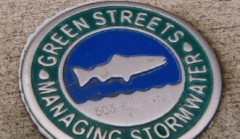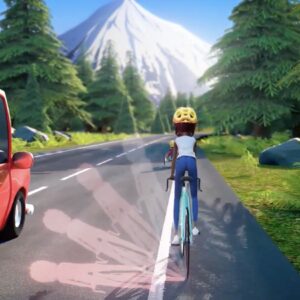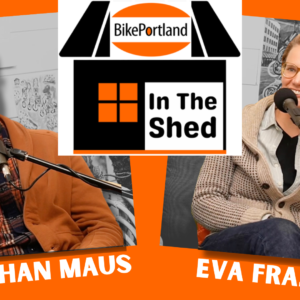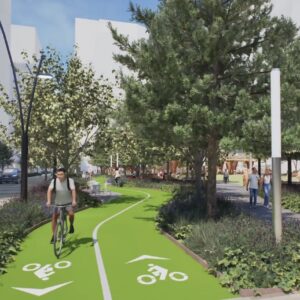
– Watch video below –
With Mayor Sam Adams’ recent announcement that he hopes to find $20 million for bike projects in Portland’s Green Streets program, you might be wondering what exactly a green street is. Today I came across a video (watch it below) on the City’s website that gives a nice overview.
The video is by Net Green News and it features the City’s Sustainable Stormwater Division Manager Linda Dobson. In the video, Dobson says, “The green and the vegetation can not only manage the stormwater and clean it up, but it also makes for nicer streetscapes and it can enhance the bicycle and pedestrian environment.”
Watch the video below:






Thanks for reading.
BikePortland has served this community with independent community journalism since 2005. We rely on subscriptions from readers like you to survive. Your financial support is vital in keeping this valuable resource alive and well.
Please subscribe today to strengthen and expand our work.
The City has also used these “green street” programs to address ADA sidewalk ramps and other concrete improvement projects. This looks like a little more creative accounting financed by your sewer fees.
I live on a Green Street and I’ve said this before, but the City chopped down MANY trees, large and small, on my street and in my neighborhood to put in the planters. There’s got to be a better way to do it.
Here, here for green streets. Almost 70 % of Portland’s urban stormwater comes from or ends up in paved streets in the public right-of-way. In the process, run-off picks up most of the pollutant loads that can end up in our streams and rivers.
So green streets and bike blvds are an ideal match: complete streets that work for people, wildlife and watersheds.
What happens when these things become saturated with pollutants, don’t they just run on through? Plus ordinary soil is almost saturated, as evidenced by the difficulty to fertilize, how much is actually being captured here? If there is pollution being gathered here, then surely the plants themselves are contaminated, seeds too. What about fauna that consumes contaminated vegetation, and seeds? Once there is a pollutant build-up are these things safe? How is forcing me out into traffic on my bike safer for me?
I agree that storm water run-off should be harvested and utilized as a resource, but this looks like a bunch of pretty posies; and feels like I just got took by the granola-set. Perhaps we could constrain the flower-pots to people’s front porches, and their checking account, yes?
Good questions Vance.
Soil microorganisms, fungi, green plants or their enzymes break down most toxins in stormwater through a process called bioremediation. It is true that some heavy metals are stored in the soil but research to-date has found that it would take very heavy pollutant loads over very long periods to saturate the soil’s capacity to store them (ofcourse this depends on greenstreet design too). If that would occur- and lots of ongoing research is investigating this question with different green street designs- the soil might simply have to be replaced. But this is far easier, cheaper, and preferable to letting the heavy metals enter our streams and rivers were they pose a variety of uncontrolled impacts to human and ecosystem health.
Of course the long term solutions will be to eliminate pollution at its source: the hydrocarbons and heavy metals from cars and the combustion engines. More people biking and walking is part of that solution which is why the benefits for traffic calming and enhanced bike and pedestrian safety are compound benefits for human and ecosystem health.
So green streets are absolutely NOT just about “bunch of pretty posies” (although they are that too): they are about integrating ecological functions into the urban environment in ways that healthy people and wildlife can flourish together.
Jim
Nick: Are you sure the trees were removed to install the greenstreet?
Some street trees have to be removed because they were wrongly planted in the first place and are tearing up the street, requiring expensive maintenance or creating other problems.
While it is possible, I doubt the city foresters would allow removal healthy non-problem trees to put in a green street. However is more likely green street (some of which include trees) was installed mitigation for removal of trees that had to be removed for another reason.
well at least we’re getting something for having some of the highest sewer charges in the nation.
Jim Labbe #5-6 – Thanks for that Mr. Labbe, sorry been busy. Well, you articulate that ordinary soil holds quite a bit more goop than I had thought. Interesting that, ’cause getting fertilizer to ‘take’ is a nightmare, precisely because soil is already so saturated by the periodic-table; and not just the left side. Clearly, I’m mistaken, thanks for clearing that up.
One question crops up then. Once the soil is saturated with pollutants you say the plan ‘may’ be to turn the soil over, to replace it? Is that about right? Of course the question this raises, is where does the contaminated soil go after removal and replacement; and is there any danger that this toxic-waste may be produced in amounts that are dangerous?
I would reiterate that I’m all for managing this. It’s just that these things are very expensive, relatively speaking, and have what I consider to be a major detractor in that they almost have to be contained within a curb-extension; which I feel endangers my personal safety while riding a bicycle around them.
One more thing. I know for a fact that benzene, the strongest carcinogen known to man, is fairly impervious to bio-remediation, by way of for-instance. Benzene is a petroleum byproduct, but is also produced when legumes, and seeds rot. My concerns are that in addition to loads of contaminated soil to deal with, that there are going to be plants available to wild fauna which contain high levels of this chemical inherently.
Is there cause for concern? I am skeptical about the safety of wild-birds, and neighborhood pets being exposed, at least, to concentrated levels of benzene. Also a teency-tincy molecule that is airborne in a soft-breeze. This guy atomizes at the drop-of-a-hat, and might find it’s way into a human lung or six.
Vance,
This stormwater mitigation stuff has been going on (and escalating) for a long time. Have you ever really felt pushed into traffic by it? You brag about how poor you are, and how little money you earn. Do you really worry about what stormwater projects are doing to your taxes?
If someone just made something up and wrote about it here, would you feel compelled to make the counterpoint? How many adovocates does the devil’s advocate need?
Especially when someone is making a good point, well articulated by your own admission, you just don’t like it. Good God, dude. I’ve been reading your negative postings for quite a while. I even went to your blog a time or two. What a downer. You’ve established yourself as a heckler, and we do need hecklers, but is that you, all the time? That’s it?
We all love the bioswales. Naysayers will always be there to whine, that’s how you know it’s progress 😉
Vance,
No. Unless you plan on eating large quantities of soil in a bioswale (I would not recommend it), the heavy metals immobilized by green street bioretention are far more hazardous in our air and water. For example the copper from automobile break linings that ends up in our water bodies and can be lethal to salmon (and probably other aquatic life) also end up in our air where it creates a real health hazards to people.
Hart #11 – I’m not nay-saying, yet. I’m only skeptical because to date these have consumed either highway space, or sidewalk space, or both, when installed. There are legitimate detractors like cost, and when they are ‘conjoined’ with a curb-extension, their impact on bicycle traffic. My position is simple, is the pros-column longer than the cons-column? I’ve identified these so-called bioswales as an area of possible compromise, on my part, and am just asking questions.
JL #12 – I don’t plan on eating the dirt, c’mon. In fact, I’ve repeatedly mentioned wild fauna, like birds, and other creatures that eat seeds, and wild plants. It is the plants in there that I’m worried about getting eaten. You said bio-remediation, and I pointed out that not all harmful chemicals are subject to breakdown this way. Which leaves unanswered the question as to how much of, IF ANY, hazard these plants may pose to wild-life, and neighborhood pets.
What’s in our air that these bioswales will trap? That just doesn’t make any sense. Airborne pollutants aren’t likely to be filtered out this way, or all the other flora on Earth would be ‘scrubbing’ the air clean and we wouldn’t have a problem. As an example you site ‘copper’ as a source of air-pollution. I’ll give you the benefit of the doubt and chock that up to authoring web-comments in haste. But, since we’re talking about copper from brake-pad-linings, I’m fairly certain that metal brake-pads have been, or are proactively being, phased out by Federal regulation. Historically, they’re cheaper than ceramics or we’d have never seen the poorer performing metal pads in the first place.
Mission to filter run-off=good. I’m not certain there is enough of a pay-off though, where bioswales are concerned. For instance, I’m much more interested in treating the run-off in plants, like we do sewer waste. I think it’s perfectly fair to question the efficacy of these because a significant amount of these would equal the resources it might take to build such a facility.
Plus too, I’ve seen zero plans, not saying there aren’t any, for managing these if and when they become contaminated and/or saturated. Mr. Labbe, clearly you know more about these than I, and you’ve been kind and patient answering questions.
Lastly, if these really aren’t that effective but enjoy broad support for some other reason, well I’d like to understand this other reason. I’m fearful that these are something like a giant Christian Cross with a bird-feeder affixed so that it might pass muster as a treatment rather than simply a proselytizing tool for a church I don’t want to join, if you catch my meaning.
Poor form that, building monuments to one’s religion with public money.
Okay, some will surely think I am wasting my time responding to Vance but he keeps raising issues that actually demonstrate the benefits of green streets.
Vance: The City and other municipalities across the country have done piles and piles of research on the cost-effectiveness of collecting, transporting, and treating stormwater at centralized facilities versus treating it close to its source through green streets, eco-roofs and other sustainable stormwater strategies. Time and time again the latter shown to be MUCH more cost-effective both in upfront capital costs and long-term operations and maintenance. In fact, green streets are increasing popular among some developers because they cost less than the system development charges to hook up to the stormwater system.
If your concern is really wildlife contamination, think about it again. Properly designed green streets can clean most of the toxics in our stormwater through bioremediation and store heavy metals through bioretention. Are our wildlife really better off if all the toxic stormwater ends up in our streams and rivers, especially in the near term? Sure treating in a centralized facility might get to 100% safety for wildlife sometime in a more expensive future but that contradicts your first point about cost.
If your concern is really the toxic impacts of stormwater to wildlife (and I’d be a bit surprised that it is) it is not clear the alternatives would be any better. However, it might be better to spend your energy advocating for alternatives to cars and trucks due to their toxicity to people and wildlife (see above).
In the meanwhile green streets remain part of the solution to the problem and to many others.
Finally, airborne copper comes from the wearing down of break pads in small enough sizes that it then gets suspended in the air around streets and freeways When it rains, it enters stormwater run-off.
Thanks,
Jim
Vance,
My info from the city says FOUR times a year the dirt will be REMOVED and replaced. THAT CAN’T BE RIGHT. Maybe it was once a year.
If we made the bioswales years ago we would not have had to make the billion dollar pipe. These are much nicer to look at too (and the cats love to play in them). If at some point the bottom of the swale gets too much silt accumulated in it (usually washed onto the street from neighbors yards and diveways) it will be shoveled out and be made good again. this is a many century old idea that is coming full circle again. Kudos to Sam for getting this one right. Relativly small investments now will reap big savings for decades to come (and I’m usually critical of Sam)
So our household sewer rates are so high (#7) in part because we are paying to clean up pollution that mostly comes from cars (#5). And the anti-bike crowd says its bicyclists don’t pay there way?
At least we get some we get some greener and more bike and pedestrian friendly streets.
Jed-
Nobody said cars are paying for the big pipe or that bikes are either. The storm drains are going to flow into the sewer with or without cars on the street. the bioswale only reduces that grey water from the sewer system. High sewer bills has nothing to do with cars. One percent of the cities construction budget goes to support green street, new construction projects pay for their own facilities. If you have ever had a sewer back up into your basement, you would be a big fan of bioswales ability to reduce the load on our overloaded sewer system.
The benifit of having a whole bunch more greenery along the street is really nice also.
perhaps some of that stimulus money could be used tomake more bioswales? and not just portland,anywhere that they have similar sewer problems. Just think how many people could be employed building these, and maintaining them afterword.